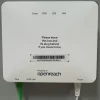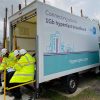YouFibre Become First UK ISP to Take 400G Port at LINX Manchester

Alternative UK broadband provider YouFibre, which is one of the retail outlets for Netomnia’s (Brsk) growing 10Gbps capable Fibre-to-the-Premises (FTTP) network, today claims to have become the first ISP to take a 400G (Gbps) port at the London Internet Exchange’s (LINX) regional interconnection hub in the North – LINX Manchester.
Just for some context. Netomnia’s full fibre network currently covers over 2.08 million premises across parts of more than 90 UK cities and towns, although they’re aiming to reach 3 million homes and businesses by the end of 2025. The network is also home to a total of 238,000 customers via Brsk and YouFibre, and they have an ambition to reach 1 million customers by 2028.
Crucially, YouFibre has more than doubled their customer base over the last 12-months, and they’ve also indicated their desire to introduce ADTRAN’s cutting edge 50G PON kit across their network (here). The first products on their new 50Gbps capable broadband platform are due to launch in the very near future, but all of this growth and enhanced connectivity also requires more capacity.
Advertisement
Suffice to say that taking out a 400G port at the Manchester internet exchange is a key part of that capacity drive. Such IXP locations serve as a critical meeting point for ISPs, content networks, media, gaming, finance and enterprise to meet via a single cross connect to share traffic for low latency end user experiences.
The regional IXP, operated by LINX, has experienced growth of its own lately with multiple traffic peaks, tipping the 700Gbps mid-February to then be extremely close to 800Gbps, following the latest Call of Duty and Fortnite gaming updates.
Sam Defriez, Network Director at YouFibre, said:
“We have been monitoring our network traffic growth on a regional level and we’re always looking to stay ahead of user demand, especially in big moments like a gaming update, which has driven our decision to install 400G ports in key locations, starting in Manchester. We will be looking to roll out to more locations through 2025.”
Colin Peckham, Interconnection Manager for LINX and LINX Manchester Lead, said:
“Manchester continues to evolve as a key digital hub and we are seeing new networks connecting into LINX Manchester for more efficient network routing and content delivery as well as existing members, like YouFibre, increase their capacity.
Our Internet Exchange Points across the UK are designed exactly the way that YouFibre are utilising them. Taking a 10G or 100G port at each site in London, Wales, Manchester and Scotland to keep their traffic local. This is especially valuable when our LINX membership fee of £100 per month includes at 10G port with 2Gbps of service at each location for this reason.”
The LINX Manchester networking community is accessible from five data centres across the metro; Equinix, Datum, Pulsant, Lunar Digital and AtlasEdge. Networks meet at the IXP regardless of which data centre they are co-located, creating more opportunities for effective network routing. But normally it’s only global content delivery (CDN) networks or global carriers who have traditionally had demand for the latest 400G solutions.
The news comes only a few months after alternative full fibre broadband provider toob proclaimed itself to be the first UK ISP to take a 400G port at LINX’s largest LON1 (London) Ethernet switching platform for their peering services and more (here).
Advertisement
Mark is a professional technology writer, IT consultant and computer engineer from Dorset (England), he also founded ISPreview in 1999 and enjoys analysing the latest telecoms and broadband developments. Find me on X (Twitter), Mastodon, Facebook, BlueSky, Threads.net and Linkedin.
« Streetwave to Map 4G and 5G Mobile Cover Across Liverpool City Region























































Welcome news, although unsure how it works in practice for BRSK customers? From what I can see, post YouFibre acquisition, BRSK now only peers with YouFibre, and only at Linx London. So at present, BRSK customers at least cannot benefit from this?
As a Brsk customer, I can confirm, we only get London peering.
Brsk only has BNGs, the equipment that breaks customers out into Internet Protocol, in London right now.
Obviously this can and will change. Moving them behind the YouFibre IP network/ASN was easier but getting Brsk customers onto regional BNGs as YouFibre customers are to take full advantage of YouFibre transit and peering, reduce traffic going around the country internally and improve latency will happen.
I’d be interested to hear about the economics of bigger ports at exchanges vs. operating caching servers within your own network for things like large game updates.
Caches are more economical for the ISP as long as the volume is there however it’s not up to ISPs whether they can cache those updates or not, the content delivery networks decide whether ISPs get to host their server clusters or not.
As the transaction between customer and CDN is encrypted the ISP has no way of knowing what they asked for and without the CDN’s private key they can’t proxy HTTPS sessions.
A common way to go if the scale is there is to connect the networks directly over a pair of fibres rather than across a public exchange. Good intermediate step between on-net caches and public peering.
I am sure I have seen B4RN have 400G ports at Manchester.
Unless it was pretty recently installed doesn’t look like it:
Broadband for the Rural North (B4RN) http://www.b4rn.org.uk 58273 Open 195.66.244.60 2001:7f8:4:2::e3a1:1 2c4c.15d7.8392 Equinix MA1 Williams House (TCW) edge8-tcw-man1 ce15/1 100G
It’s the first time in the North of Ireland I’ve had a connection that exits somewhere on the island, with 6ms from Derry – Dublin – love to know where they have the BNGs
Yours is probably in Dublin
yeah it could well be looking at traceroutes, didn’t think they would have any in the ROI
It’s the closest place to you to get to the wider Internet 🙂
They have both at least one BNG and a transit and peering router in a Dublin datacentre. Collect together their Northern Ireland network in a key exchange and rent dark fibre or a wavelength from there across the border to Dublin.
I said the ‘probably’ as I wasn’t sure if you had been moved there but, yes, that would track. Gives you better performance than taking you to Manchester to get to places and means regionalised content.
Thanks for the information! Running reverse tracerts seems to show the route going via Dublin-Manchester via Zayo. I wish they had reverse dns on their network making it easier to track the routing.
https://www.speedtest.net/result/17491792946 – i’m happy for the first time – I can connect to servers in Ireland not going through Manchester or London.